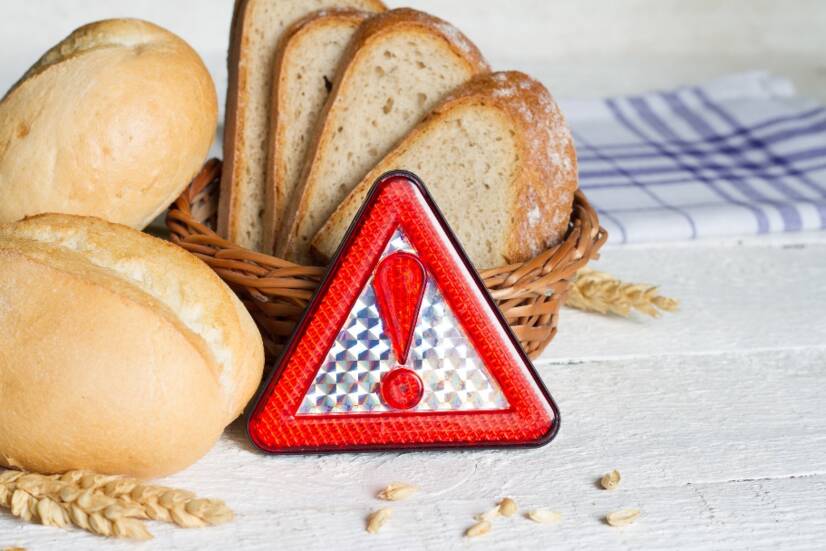- solen.sk - Food allergy. Solen. Hana Kayserová
- solen.sk - Celiac disease - standard diagnostic and therapeutic procedure. MUDr. Zuzana Blusková, PhD., MUDr. Iveta Čierna, PhD., MUDr. Dagmar Székyová
- healthline.com - What Exactly Is Gluten? Here's Everything You Need to Know. Healthline. Ansley Hill, RD, LD and Brierley Horton, MS, RD
- ČÁP, Petr and Ondřej RYBNÍČEK. Allergology in your pocket. Prague: Mladá fronta, 2019. Aeskulap. ISBN 978-80-204-5255-9
Gluten intolerance: where is it found and what foods contain gluten?

Gluten is one of the most common food intolerances. People suffer from digestive problems after eating it. What is gluten and which foods does it occur in?
Article content
Gluten is made up of a complex of proteins and forms part of several staple foods.
The importance of gluten, intolerance, celiac disease, foods containing gluten, the principle of a gluten-free diet and many other interesting information can be found in the article.
What is gluten?
Gluten is the name given to a group of proteins found in grains including wheat, rye, spelt or barley. These proteins are also known as prolamins. Gluten is therefore a complex of proteins, especially glutenin and gliadin.
The individual gluten proteins are linked by strong bonds which, in conjunction with their structure, create the specific technological properties of gluten.
Its primary function is to create elasticity in dough and its ability to rise. It is an additive that creates texture, strength, elasticity. At the same time, it retains moisture and flavour in the finished food. Therefore, it is often found in products where we would not expect gluten.
It is added to most foods as a binding agent. It is particularly important in baking, as gluten makes dough fluffy, elastic and crisp. It is particularly important in the production of pastries, pasta and other flour products.
Although gluten has no nutritional value, it is used for its physiological properties in flour processing.
Basic foods containing gluten include flour, wheat starch, pasta and various types of bakery products.
Daily gluten intake varies around the world due to traditional cuisine and dietary patterns. In Western countries, daily gluten intake varies between 5 and 20 g of gluten.
Why can gluten cause problems?
The protein found in gluten (gliadin) can cause certain health problems. It contains peptides that are harder for some people to break down in the digestive tract.
The digestive complications are mainly due to the fact that gliadin has a high content of amino acids that enzymes are unable to break down - to break down. It is these undigested residues containing proline that form compact structures that can cause undesirable reactions.
Gluten proteins are thus resistant to our proteolytic enzymes of the digestive tract.
Gluten intolerance
Gluten intolerance is one of the basic food intolerances. It is an unusual reaction of the body to the intake of certain foods and dietary components.
It is diagnosed in people who have adverse symptoms and health problems after eating gluten, but test negative for both gluten allergy and celiac disease.
The cause of gluten intolerance is not fully understood. In most cases, affected individuals have a disrupted intestinal lining, increased permeability of the intestinal mucosa or disrupted intestinal microflora.
When diagnosing intolerance, celiac disease and wheat allergy should be excluded.
Common symptoms after gluten consumption are abdominal pain, headache, problems with defecation (diarrhoea), bloating, joint pain or increased fatigue.
Gluten allergy
A food allergy is an excessive, hypersensitive pathological reaction of the immune system to a particular food or dietary component.
Symptoms of gluten allergy appear relatively quickly and can be more or less severe. In an allergy, the body reacts to gluten with an exaggerated immune response.
The most common allergen containing gluten is wheat, which is also one of the most common food allergens. An allergic reaction can be triggered not only by gluten, but also by any of the proteins present in wheat.
This allergy is therefore also referred to as wheat allergy.
Symptoms include itchy skin, runny nose, watery eyes, impaired breathing and, last but not least, irritation of the digestive system - vomiting, abdominal pain and difficulty defecating.
Celiac Disease
Celiac disease is an autoimmune disease in which a permanent gluten intolerance is present.
In celiacs, ingested gluten causes damage to the lining of the small intestine, which attacks the body's own immune system. Subsequently, an inflammatory process in the intestines occurs and the lining of the small intestine is damaged, through which nutrients are absorbed into the body.
The villi of the small intestine are damaged.
Symptoms of celiac disease include abdominal pain, bloating, headache, diarrhoea, vomiting, itchy skin and others. The risk is malnutrition, excessive weight loss, damage to the intestines and other serious digestive problems.
Diagnosis of gluten intolerance involves taking a comprehensive medical history and a blood sample from the patient for laboratory testing.
In gluten allergy, the production of specific IgE antibodies is present in the body. Serological testing can specifically target IgE against wheat flour, barley, oats and other foods.
Coeliac disease is then determined by serological laboratory tests confirming immunoglobin antibodies in the IgA class and antibodies in the IgG class. If antibodies are present in the individual's blood, a biopsy of the lining of the small intestine can be performed to confirm the diagnosis of celiac disease.
When diagnosing gluten intolerance, it is important to rule out celiac disease and wheat allergy. The body's response to a gluten-free diet is also investigated. When gluten intolerance is suspected, antibodies to gliadin (a gluten protein) in the IgA and IgG classes are detected.
However, if celiac disease is ruled out and there is an improvement in health after a gluten-free diet, it is possible to speak of gluten intolerance.
The pharmaceutical market currently offers over-the-counter home tests for food intolerance. However, a professional medical examination and a laboratory blood test are required to make an accurate diagnosis.
Gluten-free foods - how to find out?
Gluten is mainly found in cereals and cereal products, but it can also be found in ice cream, yoghurt, flavourings, alcohol and other products. Reading the ingredients of the food is therefore the key to a gluten-free diet.
Since 2016, the European Union Regulation 828/2014 on requirements for the provision of information to consumers on the absence or reduced gluten content of foods has been in force.
The final product should be labelled as gluten-free or as having a reduced content not exceeding 100 mg/kg of food.
Foods labelled as gluten free or 'gluten free' with the crossed-out cob symbol may contain traces of gluten up to a maximum of 20 ppm per 1 kg of food.
It is first necessary to look at the allergen list to see if the product contains wheat, and then to check the ingredients for other sources of gluten. Often manufacturers make the job easier by labelling a gluten-free product with a crossed-out ear as a certified gluten-free food.
Examples of gluten and gluten-free foods
Inappropriate foods containing gluten:
- Cereals with gluten: wheat, rye, oats, barley, bulgur, spelt, kamut, triticale
- Gluten-containing foods: flour, bran, sprouts, groats, wheat-based pasta, breadcrumbs, wheat-based baked goods, cereals, soy wheat sauce, starch, malt, dextrin, beer, hydrolysed vegetable proteins (some meat substitutes), etc.
Suitable foods for a gluten-free diet:
- Gluten-free cereals: corn, rice, buckwheat, buckwheat, amaranth, flax, tapioca
- Legumes: soybeans, lentils, beans, chickpeas, peas
- Meat and eggs
- Potatoes
- Milk, butter, cheese
- Seeds and nuts
- Fruit and vegetables
- Sweeteners: honey, maple syrup, cane molasses, brown sugar, coconut syrup, agave syrup, etc.
Attention: nowadays, the market offers a number of gluten-free foods that at first glance would appear to contain gluten. These include gluten-free bread, gluten-free pasta, gluten-free cereals and many others.
What replaces gluten?
For example, the composition of gluten-free flour also depends on the exact purpose for which the flour is made. Sometimes it is made from cornmeal, cornstarch, buckwheat, rice flour, potato starch or specific gluten-free thickeners.
In gluten-free bakery products, gluten is replaced by stabilisers and other thickeners such as xanthan gum or hydroxypropylmethylcellulose.
It has no confirmed adverse effects on human health and is therefore an officially authorised food ingredient within the European Union.

Gluten-free diet
A gluten-free diet is no different from other diets - except that it does not include foods containing gluten. A healthy gluten-free diet also includes a balanced regular intake of macronutrients (protein, carbohydrates, fat) and fibre.
A gluten-free diet is a diet that does not contain gluten. However, with gluten intolerance, it does not have to be as strict as with allergies and especially celiac disease. With celiac disease, some people have to watch the composition of supplements, medications or trace amounts in food products.
Nowadays, every food product has the exact ingredients and gluten content information written on it. Reading the ingredients of products is thus a common part of a gluten-free diet.
Gluten-free foods now have their own sections in stores, which are becoming more and more widespread due to increased demand.
Is a gluten-free diet also suitable for healthy people?
Gluten-free diets have been gaining popularity in recent years even among individuals who have no problem digesting gluten. Gluten intolerance occurs mainly due to health reasons with the gastrointestinal tract.
However, some people restrict it out of some belief that it is harmful to the body. To date, however, there is no official evidence of the benefits of gluten restriction or its harmful effects.
Therefore, experts advise healthy individuals not to eliminate gluten from their diet and to consume a reasonable amount of gluten as part of their individual daily intake.
Interesting resources










